
Functional vs. Traditional: Training Methods for the Modern Elite Athlete
Functional vs. Traditional: Training Methods for the Modern Elite Athlete
The world of sports and athletic performance has witnessed significant evolution over the years. With these changes come varying methodologies and philosophies surrounding elite athlete training. Two of the most discussed methods in recent times are functional and traditional training. While both have their merits, understanding the nuances and applications of each can shape athlete training programs more effectively.
Understanding Traditional Training
Traditional training has been the cornerstone of most athlete training programs for decades. It emphasizes:
- Isolated Movements: Exercises in traditional training usually focus on a single muscle group. Think of bicep curls, leg extensions, and bench presses. They target specific muscles without necessarily mimicking the movements in an actual sport or activity.
- Strength and Hypertrophy: The primary goal of traditional training is to increase muscle size and strength. This is achieved through methods like progressive overload, where athletes gradually increase their weight or resistance to challenge their muscles.
- Stability: Traditional exercises often utilize stable environments, such as benches or machines, where movements are controlled and predictable.
Diving into Functional Training
Functional training, on the other hand, is a more holistic approach to athlete training and health. It emphasizes:
- Compound Movements: Instead of isolated exercises, functional training often involves multiple muscle groups. Movements like squats, deadlifts, and pull-ups engage various muscles, replicating the natural movement patterns we use in daily life or sports.
- Sport-specific Activities: Functional training focuses on mimicking movements specific to an athlete’s sport. For a basketball player, this might involve plyometric exercises to enhance jumping ability.
- Core Strength & Balance: Many functional exercises engage the core and enhance an athlete’s balance. They may use unstable platforms like Bosu balls or wobble boards to challenge an athlete’s stability.
Functional vs. Traditional: Which is Superior for Elite Athlete Training?
The debate about the superiority of one method over the other is ongoing. However, the choice often boils down to the athlete’s goals and the specific demands of their sport. Here are some considerations:
Both functional and traditional training methods play crucial roles in athletic development, with each offering a distinct approach to fitness. Here are some authentic differences:
Nature of Exercises:
- Functional: Emphasizes multi-joint, compound movements that mimic real-world activities. Examples include squats, deadlifts, and push-pulls.
- Traditional: Focuses on isolated exercises targeting specific muscle groups, often using machines. Examples are bicep curls, leg extensions, and bench presses.
Purpose:
- Functional: Aims to enhance everyday movement patterns, improve balance, and reduce injury risks in real-life scenarios.
- Traditional: Primarily targets muscle hypertrophy, strength gains, and body sculpting.
Equipment:
- Functional: Often utilizes body weight, free weights, resistance bands, and stability balls.
- Traditional: Primarily uses fixed machines and dumbbells.
Adaptability:
- Functional: Can be easily adapted for sport-specific training, mimicking movements and scenarios from the athlete’s respective sport.
- Traditional: While it can be tailored for specific sports, it primarily focuses on general strength and muscle development.
Risk of Injury:
- Functional: When done correctly, functional training can help decrease the risk of injury by improving body mechanics and movement efficiency.
- Traditional: While effective for muscle building, there’s a potential risk if exercises are performed with poor form, especially when using heavy weights.
Flexibility & Mobility:
- Functional: Typically integrates flexibility and mobility work, promoting a full range of motion.
- Traditional: Might not emphasize flexibility as much, with the main focus being on muscle strength and endurance.
In determining superiority, the choice between functional and traditional training largely depends on the athlete’s goals, the specific demands of their sport, and individual preferences. Often, a hybrid approach that integrates the strengths of both methodologies can be most effective for holistic athletic development.
The Impact on Athlete Training and Health
An athlete’s health and wellbeing extend beyond just physical strength or agility. It’s about ensuring long-term health, optimizing performance, and reducing injury risks. A well-rounded approach, which blends the best of functional and traditional training, can be the key to achieving these goals.
Functional exercises, with their emphasis on balance and core strength, can improve posture, enhance mobility, and offer better muscular balance. Traditional exercises, with their focus on isolated muscle growth, ensure that athletes have the strength needed for their specific sports.
Conclusion
In the ever-evolving world of elite athlete training, there’s no one-size-fits-all approach. Both functional and traditional training have their place, and their effectiveness often depends on the athlete’s goals, the demands of their sport, and individual preferences.
As athlete training and health become more nuanced and research-driven, it’s evident that integration, rather than isolation, might be the way forward. Athlete training programs that harness the strengths of both functional and traditional methods will ensure athletes are not only powerful and agile but also resilient and prepared for the unpredictable nature of sports.



